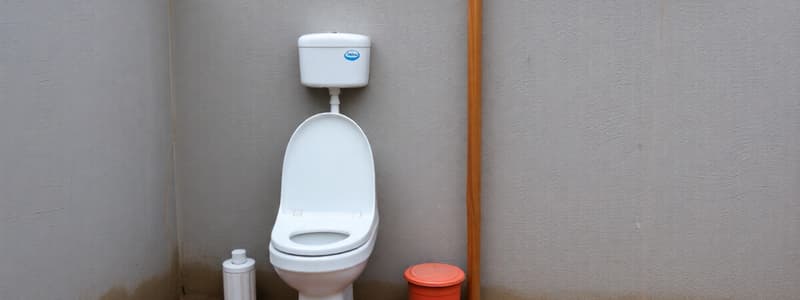Podcast
Questions and Answers
What is the primary purpose of a toilet according to design principles?
What is the primary purpose of a toilet according to design principles?
- To reduce environmental impact
- To serve its primary purpose effectively (correct)
- To enhance aesthetic appeal
- To provide entertainment
Which material is commonly preferred for toilet bowls due to its durability and ease of cleaning?
Which material is commonly preferred for toilet bowls due to its durability and ease of cleaning?
- Ceramics (correct)
- Stainless Steel
- Concrete
- Plastic
What sanitation practice is essential for maintaining hygiene and reducing disease transmission?
What sanitation practice is essential for maintaining hygiene and reducing disease transmission?
- Creating aesthetic designs
- Installing automated lighting
- Regular cleaning (correct)
- Providing additional seating
Which feature is important for enhancing user accessibility in toilet design?
Which feature is important for enhancing user accessibility in toilet design?
What is a common method to ensure proper sanitation near toilets?
What is a common method to ensure proper sanitation near toilets?
Flashcards are hidden until you start studying
Study Notes
Toilet Design Principles
- Functionality: Ensure the toilet serves its primary purpose effectively (waste disposal).
- Privacy: Design must provide adequate privacy for users.
- Ventilation: Include proper ventilation to minimize odors and promote hygiene.
- Ease of Use: Ensure controls are intuitive and simple to operate.
- Aesthetics: A visually appealing design can enhance user experience.
Materials For Construction
- Ceramics: Commonly used for toilet bowls due to durability and ease of cleaning.
- Plastic: Lightweight and resistant to corrosion; often used for toilet seats.
- Stainless Steel: Durable and hygienic, suitable for public restrooms.
- Concrete: Used in construction of toilet facilities, especially in rural areas.
- Eco-friendly Materials: Bamboo and recycled plastics are gaining popularity to reduce environmental impact.
Sanitation Practices
- Regular Cleaning: Establish a cleaning schedule to maintain hygiene and reduce disease transmission.
- Handwashing Stations: Ensure availability of soap and water near toilets.
- Waste Disposal: Provide appropriate bins for sanitary products and waste.
- Maintenance Checks: Routine inspections to ensure plumbing and fixtures function correctly.
- Education: Inform users about sanitation practices and the importance of cleanliness.
User Accessibility Features
- Height Specifications: Design toilets at a height suitable for all users, including those with mobility impairments.
- Grab Bars: Install bars to assist users in rising from the toilet.
- Space: Provide adequate space for wheelchair access and maneuverability.
- Automatic Flush: Consider hands-free flush mechanisms to enhance hygiene.
- Visual and Auditory Aids: Include features like braille signage for visually impaired users.
Toilet Design Principles
- Functionality is essential for effective waste disposal, ensuring the toilet fulfills its primary role efficiently.
- Privacy must be prioritized in design to provide a secure environment for users.
- Proper ventilation is crucial to minimize odors and promote overall hygiene in toilet facilities.
- Ease of use is important; controls should be intuitive and straightforward to enhance user experience.
- Aesthetically pleasing designs can positively impact user satisfaction and comfort.
Materials For Construction
- Ceramics are widely used for toilet bowls due to their durability and ease of cleaning, making them a standard choice.
- Plastic is favored for toilet seats because it is lightweight and resistant to corrosion, contributing to longevity.
- Stainless steel is ideal for public restrooms due to its durability and hygienic properties, often chosen for high-traffic areas.
- Concrete is commonly utilized in constructing toilet facilities, especially in rural or less developed areas, providing structural integrity.
- Eco-friendly materials like bamboo and recycled plastics are emerging trends, aimed at reducing environmental impact during production.
Sanitation Practices
- Establishing a regular cleaning schedule is vital to maintain hygiene levels and minimize disease transmission risks.
- Handwashing stations should be equipped with soap and water to promote cleanliness immediately after toilet use.
- Appropriate waste disposal facilities, such as bins for sanitary products, must be provided to maintain sanitation.
- Routine maintenance checks are necessary to ensure plumbing and fixtures are functioning correctly, preventing issues that could lead to unsanitary conditions.
- Education on sanitation practices is important for users, highlighting the significance of cleanliness and proper hygiene behaviors.
User Accessibility Features
- Design toilets at an appropriate height to accommodate all users, particularly those with mobility impairments, ensuring usability for people of diverse needs.
- Grab bars are essential additions that assist users in rising from the toilet, enhancing safety and independence.
- Adequate space must be allocated to allow wheelchair access and ensure maneuverability, promoting inclusivity.
- Automatic flush systems can enhance hygiene by reducing the need for physical contact, offering a hands-free operation option.
- Visual and auditory aids, such as braille signage, should be included to assist visually impaired users, making facilities accessible to everyone.
Studying That Suits You
Use AI to generate personalized quizzes and flashcards to suit your learning preferences.




